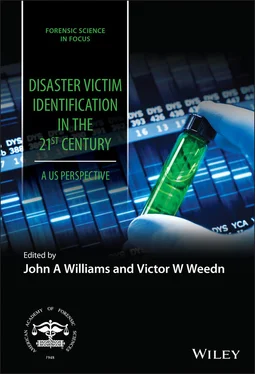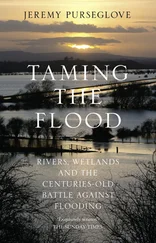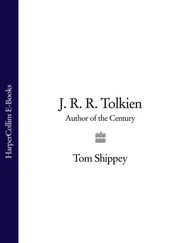Disaster Victim Identification in the 21st Century
Здесь есть возможность читать онлайн «Disaster Victim Identification in the 21st Century» — ознакомительный отрывок электронной книги совершенно бесплатно, а после прочтения отрывка купить полную версию. В некоторых случаях можно слушать аудио, скачать через торрент в формате fb2 и присутствует краткое содержание. Жанр: unrecognised, на английском языке. Описание произведения, (предисловие) а так же отзывы посетителей доступны на портале библиотеки ЛибКат.
- Название:Disaster Victim Identification in the 21st Century
- Автор:
- Жанр:
- Год:неизвестен
- ISBN:нет данных
- Рейтинг книги:3 / 5. Голосов: 1
-
Избранное:Добавить в избранное
- Отзывы:
-
Ваша оценка:
- 60
- 1
- 2
- 3
- 4
- 5
Disaster Victim Identification in the 21st Century: краткое содержание, описание и аннотация
Предлагаем к чтению аннотацию, описание, краткое содержание или предисловие (зависит от того, что написал сам автор книги «Disaster Victim Identification in the 21st Century»). Если вы не нашли необходимую информацию о книге — напишите в комментариях, мы постараемся отыскать её.
Disaster Victim Identification in the 21st Century
American Association for Forensic Sciences (AAFS) series, Disaster Victim Identification in the 21st Century: A US Perspective
Disaster Victim Identification in the 21st Century — читать онлайн ознакомительный отрывок
Ниже представлен текст книги, разбитый по страницам. Система сохранения места последней прочитанной страницы, позволяет с удобством читать онлайн бесплатно книгу «Disaster Victim Identification in the 21st Century», без необходимости каждый раз заново искать на чём Вы остановились. Поставьте закладку, и сможете в любой момент перейти на страницу, на которой закончили чтение.
Интервал:
Закладка:
Notes on the Contributors
Kenneth W. Aschheim, DDS, D-ABFO, began his forensic career following the World Trade Center attack in 2001 and is a Diplomate of the American Board of Forensic Odontology. He serves as the Assistant Chief Forensic Odontologist for NYC’s OCME and is a member of DMORT. Dr. Aschheim chairs both the ADA SCDI Forensic Odontology Informatics, and the OSAC Forensic Odontology SAC. He is a board member of the Academy Standards Board, ADA’s Standards Committees, the International Association of Coroners & Medical Examiners, and Interpol’s Forensic Odontology DVI Sub Working group. Dr. Aschheim is an Adjunct Clinical Professor at NYU College of Dentistry, a full-time practitioner, and has co-authored three textbooks on esthetic dentistry.
Jason Byrd, Ph.D., D-ABFE, is a Professor and Associate Director of the William R. Maples Center for Forensic Medicine at the University of Florida’s College of Medicine. He is a Board-Certified Forensic Entomologist and Diplomate of the American Board of Forensic Entomology. Dr. Byrd is the educational program administrator for UF’s Veterinary Forensic Sciences, Wildlife Forensic Sciences, Shelter Medicine, and Forensic Medicine educational programs. He has served as President of the American Board of Forensic Entomology, the North American Forensic Entomology Association, and the International Veterinary Forensic Science Association. He is a Fellow of the American Academy of Forensic Sciences. Dr. Byrd serves as a Medicolegal Death Investigator within the National Disaster Medical System, Disaster Mortuary Operational Response Team, Region IV, and serves as Commander for the Florida Emergency Mortuary Operations Response System.
Taylor Dickerson III, MSFS, began his career in Forensic Science in 2004 at the NYC Office of Chief Medical Examiner’s (OCME) Department of Forensic Biology, where he performed DNA testing and provided expert testimony for a wide range of criminal cases. Mr. Dickerson also supervised the identification of the victims of the 9/11 World Trade Center incident, helped develop the OCME’s Family Assistance Center procedures for mass fatality events, supervised NIJ grant funded work for missing and unidentified person cases, and served as an assistant CODIS administrator. In 2012, Mr. Dickerson joined the Armed Forces Medical Examiner System’s Armed Forces DNA Identification Laboratory (AFDIL) as Technical Leader of the Current Day Operations Section and contractor through SNA International. He oversees the DNA testing of criminal casework and current military death identifications. Mr. Dickerson served on the DNA committee of the Scientific Working Group on Disaster Victim Identification and is a current member of the AAFS Standards Board Consensus Body for DVI. Mr. Dickerson is also an Adjunct Professor within Pace University’s Forensic Science Program.
Cynthia Gavin, Ph.D., is a strategist, having a diverse background in healthcare, chemical/biological/radiological disaster response, and US military planning. Among her favorite positions, she has provided strategic advisement for the US Army, US Secret Service’s Technical Security Division, and the City of New York Office of Emergency Management and Office of Chief Medical Examiner. Building upon her thirty years of experience, Dr. Gavin has taught for the Harvard School of Public Health and the University of Maryland Baltimore County. She has published several works within the Department of Defense and private sector, some of which include Concepts of Operation development, Return on Investment, Decision Papers and creating a future vision for Disaster Victim Identification.
Bryan Johnson, MSFS, is the Major Incident Management Program Manager for the FBI Laboratory’s Latent Print Unit in Quantico, VA. He has been with the FBI since 2009 as an FBI Qualified Latent Print Examiner and has focused on mass fatality and unknown deceased issues since 2015. He oversees the FBI’s Disaster Victim Identification (DVI) Response Team, who also conducts all fingerprint identifications for the Armed Forces Medical Examiner in Dover, DE, as well as at mass fatality incidents around the globe. He has published in international peer-reviewed forensic science journals on topics pertaining to postmortem fingerprinting and digital capture of postmortem fingerprints. He currently provides regional trainings to agencies across the United States on DVI, postmortem fingerprinting, and has a passion for furthering the science and technology used.
Michal L. Pierce, MS, ASQ CMQ/OE, received her Bachelor of Science in Microbiology from the University of Illinois, followed by a Master of Science in Forensic Science from Sam Houston State University. She joined the Harris County Institute of Forensic Sciences (HCIFS) Forensic Biology Laboratory in October 2007 as a DNA analyst, and she served as the QA/Compliance Manager for Forensic Genetics from 2011 to 2013. In 2013, she was appointed as the first Quality Director for the HCIFS. In this position, she oversees the Quality Management Division, which includes quality assurance, safety, training and development, and analytical statistics. Licensed through the Texas Forensic Science Commission as a forensic analyst, Ms. Pierce possesses a professional certification by the American Board of Criminalistics in molecular biology, and she is certified as a Manager of Quality/Organizational Excellence through the American Society for Quality.
Jason Wiersema, Ph.D., is a forensic anthropologist, and the Director of Forensic Anthropology and Emergency Management at the Harris County Institute of Forensic Sciences in Houston, Texas. He earned his PhD from Texas A&M University in 2006, and his certification by the American Board of Forensic Anthropology in 2012. Dr. Wiersema has extensive experience in DVI response, including large-scale human rights and disaster responses in Bosnia, Guatemala, in Thailand after the 2005 tsunami, in New Orleans following Hurricane Katrina and in New York City as part of the Investigation of the World Trade Center terrorist attack. He has leveraged this, and his experience as a laboratory-based analyst of over 2000 forensic anthropology cases, in the development and implementation of standards and best practices for medicolegal death investigation generally and for DVI specifically. He is the current Chair of the Medicine Scientific Area Committee of the Organization of Scientific Area Committees (OSAC), and a member of the Forensic Sciences Standards Board. He is past Chair of the Disaster Victim Identification Subcommittee of the OSAC. He is the author of numerous peer-reviewed publications relevant to DVI.
Preface
In 2009 the National Academy of Sciences issued a report critical of the state of forensic science in the United States. One outcome of the report was the formation of OSAC, Organization of Scientific Area Committees for Forensic Science. OSAC’s 22 subcommittees are charged with creating standards for the forensic sciences. The formation of standards for Disaster Victim Identification (DVI) is one component of OSAC’s mission. To make these standards reality requires an SDO or Standards Development Organization. In response to this need the American Academy of Forensic Sciences established an SDO, the Academy Standards Board or ASB. DVI is included in the ASB and has its own committee or Consensus Body. It was during the routine work of the DVI Consensus Body that impetus for this book, outlining the current state of DVI in the United States, came about.
December 2021
John A. Williams
Victor W. Weedn
Series Preface
The forensic sciences represent diverse, dynamic fields that seek to utilize the very best techniques available to address legal issues. Fueled by advances in technology, research, and methodology, as well as new case applications, the forensic sciences continue to evolve. Forensic scientists strive to improve their analyses and interpretations of evidence and to remain cognizant of the latest advancements. This series results from a collaborative effort between the American Academy of Forensic Sciences (AAFS) and Wiley to publish a select number of books that relate closely to the activities and Objectives of the AAFS. The book series reflects the goals of the AAFS to encourage quality scholarship and publication in the forensic sciences. Proposals for publication in the series are reviewed by a committee established for that purpose by the AAFS and also reviewed by Wiley. The AAFS was founded in 1948 and represents a multidisciplinary professional organization that provides leadership to advance science and its application to the legal system. The 11 sections of the AAFS consist of Criminalistics, Digital and Multimedia Sciences, Engineering Sciences, General, Pathology/Biology, Questioned Documents, Jurisprudence, Anthropology, Toxicology, Odontology, and Psychiatry and Behavioral Science. There are over 7000 members of the AAFS, originating from all 50 States of the United States and many countries beyond. This series reflects global AAFS membership interest in new research, scholarship, and publication in the forensic sciences.
Читать дальшеИнтервал:
Закладка:
Похожие книги на «Disaster Victim Identification in the 21st Century»
Представляем Вашему вниманию похожие книги на «Disaster Victim Identification in the 21st Century» списком для выбора. Мы отобрали схожую по названию и смыслу литературу в надежде предоставить читателям больше вариантов отыскать новые, интересные, ещё непрочитанные произведения.
Обсуждение, отзывы о книге «Disaster Victim Identification in the 21st Century» и просто собственные мнения читателей. Оставьте ваши комментарии, напишите, что Вы думаете о произведении, его смысле или главных героях. Укажите что конкретно понравилось, а что нет, и почему Вы так считаете.












